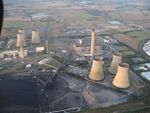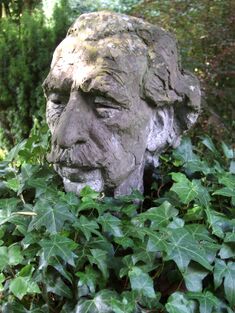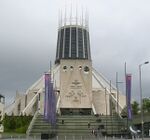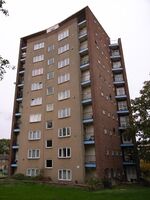Frederick Gibberd
“Pass me some more cognac, Miranda.”
| ||||
| Born: | 7th January 1908 Coventry | |||
| Mutated: | 1995 Into a sentient stone head | |||
| Alma Mater: | Unknown, received degree from wandering round the Tate Modern | |||
| Religion: | Considers himself a god | |||
| Signature: | ||||
| Master Architect | ||||
|---|---|---|---|---|
| Term of office: | 1947 - Present | |||
| Chief Advisor to Harlow Council | ||||
| Incumbent: | Robert Halfon Wayne Curtis "Kruspee" MacDunder | |||
| Preceded by: | High Council of Saint Chav | |||
Sir Frederick Gibberd (7th January 1908-present), known as Freddy Gibber to his close friends, and Friedrich to the Germans, is an award-winning British architect, garden gnome collector and sentient stone head. He is most famous for designing Harlow New Town and engineering its subsequent move to Iraq. He currently sits on a pillar in the Gibberd Garden, which his wife converted into a tourist attraction. People pay to see him and his legendary cognac-drinking abilities, and to hear his advice. He is today considered a deity. His favourite liqueur is cognac brandy, though he has expressed a passion for drambuie.
Early life[edit]
Gibberd was born in Coventry in 1908, and thus did not speak until he was nine, when his family, desperate for some stimulating conversation, left the city. His father was Gene Shalit, but Gibberd has been reluctant to disclose the identity of his mother, possibly because, according to Shalit, she was a Satanist who sacrificed Frederick's baby sister to a Dark Lord.
The family moved to London at the end of the First World War, and, to make ends meet, each member of the family had to take a job, including the ten-year-old Frederick, who became a door-to-door salesman. However, a ten-year-old who is only just learning to speak isn't the perfect door-to-door salesman, and his parents fired him, ultimately disowning him before his mother had the chance to sacrifice him, too. He wandered the streets of London for a decade, eventually learning to speak, though it only came out as a Cockney drawl. He gained an appreciation for art through wandering around the Tate Modern, though he had to stop his visits when the guards there caught him stealing elderberry cordial and banned him from the premises. He then switched his studies to the V&A. It was there, through studying the Japanese history exhibit, that Gibberd got his passion for Japanese culture and in his later life, he would become a fervent collector of anime DVDs.
Architectural fame[edit]
Eventually, Gibberd happened upon his father, who had become a television and book critic for NBC, and knocked him unconscious, stole his money, and doused him in petrol before lighting him on fire. Shalit had originally possessed a full facial beard and lovely skin, but the flames wrecked both, leaving him with an oversized moustache and a wrinkly, Yoda-like complexion. It also led to Shalit's divorce from Gibberd's mother, one of the few good things that came of the incident.
Gibberd, now fairly wealthy, started a two-year drinking spree that only ended one fateful night in 1947 when he was doing J-Bombs with the Prime Minister of the time, Clement Attlee, and conceived the idea of a New Town to solve London's overpopulation and Harlow's economic problems. Attlee also came up with the NHS; Gibberd described this idea as "balderdash", while Attlee described his plan for Harlow as "just alright". Both regret dropping so many J-Bombs that night.
Attlee pushed the plan on Parliament the following week, and everyone thought it was a good idea. Gibberd, who had no architectural experience but knew the craft from his time in the Tate Modern, designed all the buildings. He later described the end result as "remarkably shit." The building of the New Town cost the government just £35, but the result was ten times better than anything they could have accomplished in London. Many criticised the plans, and just as many praised them. The New Town's detractors were forced to concede that Gibberd was restoring the town's livelihood when he built six mega-malls, temples to the town's patron saint, Saint Chav. Around this time, Gibberd received a telegram from Shalit, congratulating his son on his newfound fame, and Gibberd responded with a hyperlink to meatspin. Shalit never contacted his son again, as Gibberd had intended.
Gibberd also had his records edited so that everyone thought he'd graduated from the Birmingham School of Art, though the school itself insists he never did.
Later life[edit]
Gibberd was required by his PR company to settle down in Harlow, to show that the housing there was "good enough for anyone". Gibberd found a loophole and bought a cottage in the Harlow district, but as far away as possible from the estates, which he conceded were a "bad idea after all". It was around that time that he developed a passion for garden gnomes. He had garden gnomes by Rodin, Henry Moore, and Barbara Hepworth installed around Harlow, and on his own property. He married a woman who happened to share the same surname as him, Lady Gibberd. When he was knighted for his services to architecture, she became the Lady Lady Gibberd.
Transformation into a disembodied head[edit]
In the 1980s, Gibberd discovered the Fountain of Youth in a bird bath on his property. He continued using it until 1995, when toxic waste from the town seeped into the bird bath. The resulting chemical soup caused Gibberd to mutate into a sentient stone head, which Lady Gibberd placed on a pillar. She then proceeded to turn their property into a tourist attraction, before running off to French Polynesia. She is presumed missing.
Gibberd later became renowned for his advice-giving skills, and his love for cognac. It was his suggestion that Harlow be moved to Iraq to accommodate the growing Polish population there, part of a master plan to get it as far away from him as possible. Today, he is an advisor to the current MPs for Harlow, EDL member, Wayne Curtis "Kruspee" MacDunder and Robert Halfon. He is considered the head (no pun intended) of his own religion, Gibberdism.

Notable works[edit]
He is most famous for designing Harlow New Town, but his other works include the Grand Cathedral of Sauron in Liverpool and Orwellian Tower, the first tower block of its kind in Britain. Another of his famous designs is the first ever lake, in Derwent, North-East England, which he described as "Like an ocean, but a bit smaller." It garnered critical acclaim and an award from God, who told him "I wish I'd thought of that!" before stealing the patent and putting them everywhere, much to Gibberd's chagrin.
A little-known fact about Sir Gibberd is that he also designed the Springfield Nuclear Power Plant from the Simpsons, the start of a strong friendship with Matt Groening that only ended when he described Naruto as "better than the Simpsons".
Critical Acclaim[edit]
Sir Gibberd has received a wide range of critical acclaim. Here are four examples:
“The underwhelming spectacle of his designs for Harlow New Town is trumped only by their sheer squalor. It's absolutely awful, but a hole in the ground is good enough for the proles.”
“COGNAC: Sir Fred reveals his love for brandy”
“The row upon row of identical houses Gibberd developed are perfect for a lifestyle of hedonism and idiocy. I know they're awful, but our readers will be comforted to know there's plenty of houses in the Old Town to convert into summer homes.”
“"I DON'T LIKE LAGER." Is Sir Freddo queer?”




